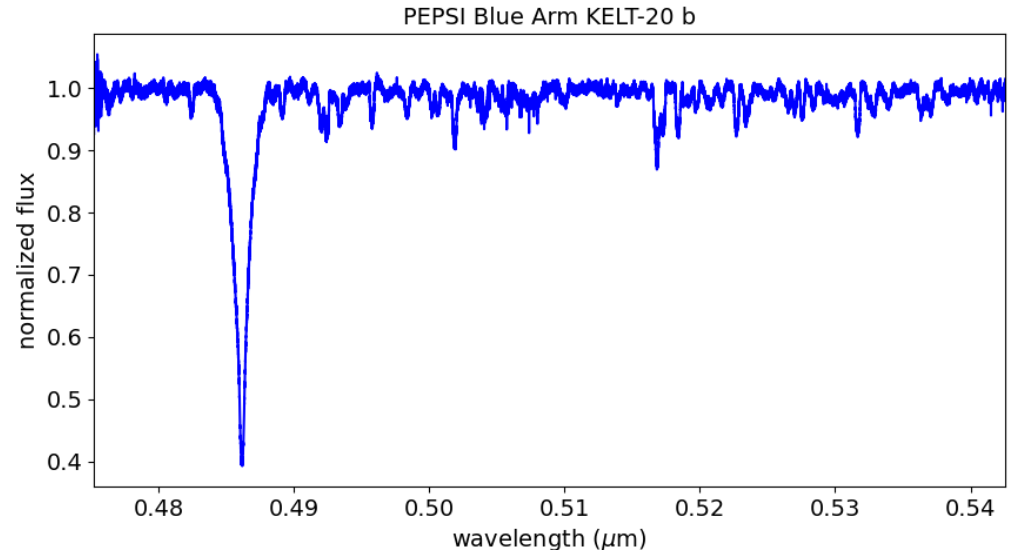PEPSI Exoplanet Transit Survey (PETS) Data at the Exoplanet Archive

Project Overview
These data were gathered under the auspices of the PEPSI Exoplanet Transit Survey (PETS) and PEPSI Investigation, Retrieval, and Atlas of Numerous Giant Atmospheres (PIRANGA) projects. The latter project is supported by NASA Exoplanet Research Program Grant 80NSSC23K0692. These are surveys of (primarily) ultra-hot Jupiters through high-resolution transmission and emission spectroscopy. These spectra can be used to extract the planetary transmission or emission spectrum, but are also suitable for stellar characterization or other purposes.
The data are all taken with the Potsdam Echelle Polarimetric Spectroscopic Instrument (PEPSI), a fiber-fed, high-resolution spectrograph on the Large Binocular Telescope (LBT) in Arizona. The data consists of two FITS files, one each from the blue (4800-5541 Å) and red (6728-7419 Å) arms of the spectrograph. The spectral resolving power for both arms is R~130,000. These are one-dimensional, wavelength-calibrated spectra, and they have already been continuum-normalized and order-combined by the PEPSI SDS pipeline. Example spectra from a single exposure of KELT-20, in both the blue and red arm, are shown below as a demonstration of the resolving power, wavelength coverage, and typical signal-to-noise ratio.

NASA Exoplanet Archive PEPSI Resources
| Planet Name | Observation Type | Observation Date (UT) | Number of Exposures | Average SNR Per Spectrum (blue arm) | Average SNR Per Spectrum (red arm) | Blue Arm Tarball Download Links | Red Arm Tarball Download Links | Citation |
|---|---|---|---|---|---|---|---|---|
| KELT-20 b | Emission | 2021-05-01 | 47 | 301 | 340 | pepsib.20210501.tar.gz ( MB) | pepsir.20210501.tar.gz ( MB)
|
Johnson et al. 2023, Petz et al. 2023 |
| KELT-20 b | Emission | 2021-05-18 | 45 | 347 | 397 | pepsib.20210518.tar.gz ( MB) | pepsir.20210518.tar.gz ( MB) | Johnson et al. 2023, Petz et al. 2023 |
Each tarball contains a set of either PEPSI blue or red arm spectra, which have file names beginning with pepsib or pepsir, respectively. The filenames also include the UT date and an integer denoting the sequence of exposures on that night. Note that the files are in FITS format despite the file extension being .nor rather than .fits.
Each spectrum includes a FITS table with columns labeled 'Arg' (wavelength, in microns), 'Fun' (normalized flux), and 'Var' (variance of the normalized flux). A minimal example to read a spectrum into Python would be:
from astropy.io import fits
hdu = fits.open('filename')
header = hdu[0].header
wavelength, flux, variance = hdu[1].data['Arg'], hdu[1].data['Fun'], hdu[1].data['Var']
hdu.close()
The wavelengths are in air and have been shifted into the stellar center-of-mass rest frame, assuming the stellar and barycentric RVs given in the RADVEL and OBSVEL header keywords, respectively. The value of RADVEL is a literature value obtained from SIMBAD, and neglects any reflex motion due to the planet.
Request for Acknowledgement
If these data are used in a publication, please cite the paper(s) for the dataset listed in the above table.
Additional Project Resources
- Potsdam Echelle Polarimetric Spectroscopic Instrument (PEPSI) website
- Large Binocular Telescope (LBT) website
- Johnson, M. et al. "The PEPSI Exoplanet Transit Survey (PETS). II. A Deep Search for Thermal Inversion Agents in KELT-20 b/MASCARA-2 b with Emission and Transmission Spectroscopy," The Astronomical Journal, 165, 157 (2023).
- Petz, S. et al. "The PEPSI Exoplanet Transit Survey (PETS) IV: Assessing the atmospheric chemistry of KELT-20b," Monthly Notices of the Royal Astronomical Society, Advance Access (2023)
Last updated: 29 November 2023




